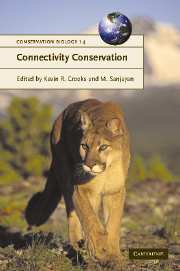Book contents
- Frontmatter
- Contents
- List of contributors
- Acknowledgements
- 1 Connectivity conservation: maintaining connections for nature
- PART I Approaches to connectivity research
- PART II Assessing connectivity
- PART III Challenges and implementation of connectivity conservation
- Introduction: Don't fence me in
- 18 Hyperconnectivity, invasive species, and the breakdown of barriers to dispersal
- 19 Disease and connectivity
- 20 Maintaining and restoring connectivity in landscapes fragmented by roads
- 21 Where to draw the line: integrating feasibility into connectivity planning
- 22 South Coast Missing Linkages: restoring connectivity to wildlands in the largest metropolitan area in the USA
- 23 Incorporating connectivity into broad-scale conservation planning
- 24 Escaping the minimalist trap: design and implementation of large-scale biodiversity corridors
- 25 The role of connectivity in Australian conservation
- 26 The future of connectivity conservation
- Index
- References
20 - Maintaining and restoring connectivity in landscapes fragmented by roads
Published online by Cambridge University Press: 24 May 2010
- Frontmatter
- Contents
- List of contributors
- Acknowledgements
- 1 Connectivity conservation: maintaining connections for nature
- PART I Approaches to connectivity research
- PART II Assessing connectivity
- PART III Challenges and implementation of connectivity conservation
- Introduction: Don't fence me in
- 18 Hyperconnectivity, invasive species, and the breakdown of barriers to dispersal
- 19 Disease and connectivity
- 20 Maintaining and restoring connectivity in landscapes fragmented by roads
- 21 Where to draw the line: integrating feasibility into connectivity planning
- 22 South Coast Missing Linkages: restoring connectivity to wildlands in the largest metropolitan area in the USA
- 23 Incorporating connectivity into broad-scale conservation planning
- 24 Escaping the minimalist trap: design and implementation of large-scale biodiversity corridors
- 25 The role of connectivity in Australian conservation
- 26 The future of connectivity conservation
- Index
- References
Summary
INTRODUCTION
Transportation networks and systems are vital to today's economy and society (Button and Hensher 2001). Not only do roads provide for safe and efficient movement of goods and people across cities and continents, throughout the world they have become a permanent part of our physical, cultural, and social environment (Robinson 1971; Lay 1992). Roads and their networks are one of the most prominent human-made features on the landscape today (Sanderson et al. 2002). Compared to polygonal blocks of built areas, road systems are linear and etched into the landscape to form a woven network of arteries that maintain the pulse of societies. However, as road networks extend across the landscape and their weave intensifies, natural areas become increasingly fragmented and impoverished biologically (Forman et al. 2003).
Although less studied compared to other agents of fragmentation, roads cause changes to wildlife habitat that are more extreme and permanent than other anthropogenic sources of fragmentation (Forman and Alexander 1998; Spellerberg 2002). Road networks and systems not only cause conspicuous changes to physical landscapes, but also alter the patterns of wildlife and the general function of ecosystems within these landscapes (Swanson et al. 1988; Transportation Research Board 1997; Olander et al. 1998). Busy roads can be barriers or filters to animal movement (Hels and Buchwald 2001; Rondinini and Doncaster 2002; Chruszcz et al. 2003) and in some cases the leading cause of animal mortality (Maehr et al. 1991; Jones 2000; Kaczensky et al. 2003).
- Type
- Chapter
- Information
- Connectivity Conservation , pp. 502 - 535Publisher: Cambridge University PressPrint publication year: 2006
References
- 18
- Cited by



